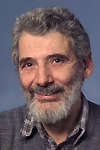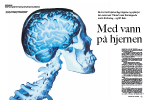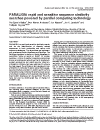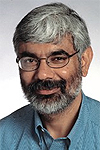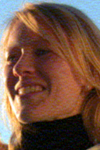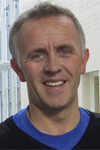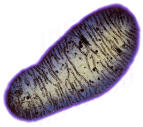
News 2005
The myelinating processes of oligodendrocytes (needed by nerve fibres to conduct at high speed) are shown to have a class of glutamate receptors previously thought to be confined to neurons: NMDA receptors make cells 'learn' but can kill them if getting out of control. Ragnhildur Káradóttir, Pauline Cavelier, Linda
H. Bergersen and David Attwell (2005) NMDA receptors
are expressed in oligodendrocytes and activated in ischaemia.
Nature,
438, 1162-1167. See also: |
|||
Hua
Hu's PhD defense Hua Hu, MD, will defend his PhD dissertation with the title
on Thursday 15 December 2005 at 1015 in New auditorium 13, Domus Medica, University of Oslo. The trial lecture with the title
will be held on Wednesday 14 December 2005 at 1415, also in New auditorium 13, Domus Medica, University of Oslo. |
|||
Juris
Allunans' PhD defense Cand.real. Juris Allunans, will defend his PhD dissertation with the title
on Monday 19 December 2005 at 1015 in the Blue auditorium, Rikshospitalet. The trial lecture with the title
will be held on Wednesday 14 December 2005 at 1400 in Auditorium A3.3067, Rikshospitalet. |
|||
Guest
lecture by David Brown Professor David Brown, Department of Pharmacology, University College, London, will give a guest lecture on Friday 16 December 2005 at 13.30 at the Department of Physiology, IMB, Domus Medica, with the title:
Twenty-five years ago, David Brown and Paul Adams discovered a novel voltage-sensitive potassium current: the M-current. They found that, unlike previously described K+ currents, the M-current was regulated by neurotransmitters, thus mediating a new type of synaptic transmission. Since then, a family of M-like channels has been identified, and mutations in these channels have been found to underlie several kinds of hereditary human disease: epilepsy, cardiac arrhythmia, deafness, etc. In his talk, Prof. David Brown will review the development of this exciting field of research. |
|||
MedCoast
Symposium – Neuroscience and metabolism
A major scientific event in the ScanBalt Forum is a plenary symposium in Neuroscience and Metabolic Disorders. This unique meeting has world leading scientists, including two Nobel Laureates, Arvid Carlsson (see image) and Peter Agre and a presentation of the latest findings in molecular biology. This symposium will discuss new hypothesis and findings about synaptic functions and brain water balance. The metabolic Syndrome will be discussed in light of new findings in molecular biology, and the importance of conditions in pregnacy and early life for later development of metabolic disorders (Obesity, diabetes and heart disease) will be disussed. Full Program for Friday. See also the EMBIO announcement. |
|||
Professor in protein chemistry, Peter Roepstorff, Department of Biochemistry and Molecular Biology, University of Southern Denmark, will give a guest lecture on Wednesday 26 October 2005 at 13.00 in the lunch room (1330), Department of Anatomy, Domus Medica, with the title:
|
|||
Dagbladet Magasinet wrote about CMBN research on brain water channels on Saturday 10 September 2005. |
|||
Vacant
position as Director of Research and Professor II The position as Director of Research and Professor II at the Department of Molecular Microbiology at Rikshospitalet-Radiumhospitalet HF and the University of Oslo is now vacant. The application deadline is 1 November 2005. For details, please see: |
|||
Guest
lecture by Ryuichi Shigemoto Ryuichi Shigemoto will give a guest lecture on Wednesday 28 September 2005 at 14.00-16.00 in the lunch room (1330), Department of Anatomy, Domus Medica, with the title:
|
|||
Guest
lecture by Marianne Fyhn Postdoc Marianne Fyhn, Centre for the Biology of Memory, NTNU, Trondheim, will give a guest lecture on Monday 12 September 2005 at 10.00 in the lunch room (1330), Department of Anatomy, Domus Medica, with the title:
The Centre for the Biology of Memory, which is lead by Professors May-Britt and Edvard Moser, brings together internationally leading neuroscientists. The goal is to investigate how neuronal ensembles in the hippocampus and neocortex give rise to specific memory operations such as encoding, storage, consolidation and retrieval. The work of Fyhn focuses on the entorhinal cortex, which gives the main cortical input to the hippocampus. The work has received a lot of attention both nationally and internationally, and the discovery of "grid cells" which comprise a neural map of the spatial environment will appear in neuroscience textbooks. The discovery of 'grid cells' opens up many avenues of enquiry about the computations underlying our sense of place, and how the hippocampus and entorhinal cortex contribute to episodic memory. |
|||
Publication on siRNA specificity RNA interference (RNAi) has become an invaluable tool for
functional Holen T, Moe SE, Sørbø JG, Meza TJ, Ottersen
OP and Klungland A (2005) Tolerated wobble mutations in siRNAs
decrease specificity, but can enhance activity in vivo, Nucleic
Acids Research, 33, 4704-4710. |
|||
The CMBN Bioinformatics group has recently launched the PARALIGN web service for rapid and accurate searches in genetic sequence databases. The work has been published in Nucleic Acids Research and covered by forskning.no. The service is freely available. Sæbø PE, Andersen SM, Myrseth J, Lærdahl
JK and Rognes T (2005) PARALIGN: Rapid and sensitive sequence
similarity searches powered by parallell computing technology,
Nucleic
Acids Research, 33, Suppl. 2, W535-W538. - En slags Google for gener. forskning.no. 3 July 2005. |
|||
Professor Shankar Subramaniam, University of California at San Diego & San Diego Supercomputing Center, will give a guest lecture on Tuesday 16 August 2005 at 12.00 in Auditorium A3.3067, Rikshospitalet, with the title:
Cells and tissues function in context. Under a given growth or survival medium they perform tasks, replicate and die. Given a stimulus they respond by invoking myriad biomolecular networks that result in a specified cellular outcome. At any given instant it can be argued that the cell is in a “state” defined by its components – their concentrations and locations, the interactions between components – that are modulated in space and time, and the complex circuitry – that involves a large number of interacting networks and a snapshot of the dynamical processes – such as gene expression, cell cycle, transport of components, etc. The manifestation of these processes is a phenotype such as a disease. How can we reconstruct the circuitry of the cell to qualitatively and quantitatively assess the phenotype from measurements of cellular constituents? This talk will address new methods for mapping genotypes to phenotypes and illustrate the power of these methods for studying insulin resistance in humans. |
|||
Guest
lecture by Kader Thiam Dr Kader Thiam, Genoway, Lyon, France, will give a guest lecture on Thursday 18 August 2005 at 14.30 in Auditorium A3.3067, Rikshospitalet, with the title:
|
|||
Cand.scient. Tonje Davidsen will defend her PhD dissertation with the title
on Thursday 23 June 2005 at 1015 in Gamle Festsal, Universitetet i Oslo. The trial lecture with the title
will be held on Wednesday 22 June 2005 at 1300 in Auditorium A3.3067 at Rikshospitalet. |
|||
Professor Richard Moxon, Molecular infectious group, Department of Pediatrics, University of Oxford, UK, will give a guest lecture on Wednesday 22 June 2005 at 14.30 in Auditorium A3.3067, Rikshospitalet, with the title:
|
|||
Professor Marit Otterlei, Department of Cancer Research and Molecular Medicine, Norwegian University of Science and Technology (NTNU), will give a guest lecture on Wednesday 22 June 2005 at 15.15 in Auditorium A3.3067, Rikshospitalet, with the title:
|
|||
Guest
lecture by John Davies Professor John Davies, Department of Microbiology, Monash University, Victoria, Australia, will give a guest lecture on Thursday 2 June 2005 at 11.00 in Auditorium A3.3067, Rikshospitalet, with the title:
|
|||
| CMBN research on the
worlds strongest molecular motor published in Molecular Microbiology The extrusion and retraction of bacterial surface filaments termed pili constitute a robust motility mechanism that generate the largest force of any known single molecular motor. Using Neisseria gonorrhoeae (the agent of gonorrhea) as a model system, CMBN researchers and collaborators have identified a family of five proteins that are required for pilus function and act as "gears" in the pilus motor. The discovery may lead to new methods to control infectious diseases and to the development of unique biological nanomotors. Winther-Larsen HC, Wolfgang M, Dunham S, van Putten JP, Dorward
D, Løvold C, Aas FE, Koomey M (2005) A conserved set
of pilin-like molecules controls type IV pilus dynamics and
organelle-associated functions in Neisseria gonorrhoeae. Mol
Microbiol., 56, 903-917. |
|||
| CMBN research on
carbonic anhydrase published in PNAS CMBN researchers have identified the enzyme that catalyses
the hydration Nagelhus EA , Mathisen TM, Bateman AC, Haug F-M, Ottersen
OP, Grubb JH, Waheed A, Sly WS (2005) Carbonic anhydrase XIV
is enriched in specific membrane domains of retinal pigment
epithelium, Müller cells, and astrocytes. Proc
Natl Acad Sci USA. |
|||
Professor Peter Agre, Johns Hopkins Medical School, Baltimore, USA (Nobel Prize in Chemistry 2003), will give a guest lecture on Wednesday 18 May 2005 at 10.00 in Store Auditorium, Rikshospitalet, with the title:
The lecture is part of the WIRED symposium on "Transport processes in the CNS: Emerging concepts". |
|||
Guest
lecture by Bert Sakmann Professor Bert Sakmann, Max-Planck Institute, Heidelberg, Germany (Nobel Prize in Physiology or Medicine 1991), will give a guest lecture on Friday 20 May 2005 at 14.00 in Store Auditorium, Rikshospitalet, with the title:
The lecture is part of the WIRED symposium on "Transport processes in the CNS: Emerging concepts". |
|||
WIRED-symposium,
18-24 May 2005 The WIRED symposium on Transport
processes in the CNS: |
|||
CMBN team runs
Holmenkollstafetten 2005 The CMBN team ran Holmenkollstafetten in 67 minutes 56 seconds and secured a fantastic 9rd place out of 77 teams in its class. The participants were very satisfied with the result and celebrated the victory Saturday night. |
|||
Postdoctoral position
available A postdoctoral position in protein biochemistry and astrocyte biology is available in the Laboratory for Molecular Neuroscience, CMBN. |
|||
Elisabeth Larsen's
PhD defense Cand.scient. Elisabeth Larsen will defend her PhD dissertation with the title
on Thursday 21 April 2005 at 0900 in Universitetets aula, Midtbygningen, Karl Johans gate 47. The trial lecture with the title
will be held on Wednesday 20 April 2005 at 1300 in Auditorium A3.3067 at Rikshospitalet. |
|||
CMBN Annual Report
2004 CMBN's annual report for 2004 is a now available. Download the PDF version or contact the CMBN administration for a printed version. |
|||
Guest lecture by
Mikael Nilsson Associate professor Michael Nilsson, Göteborg University, will give a guest lecture on Monday 4 April 2005 at 14.00 in new auditorium 13, Domus Medica, with the title:
|
|||
New Assistant director
and new Group leader appointed
|
|||
CMBN research on
DNA repair in HIV patients published CMBN researchers and co-workers have published a paper in Blood about their work on repair of oxidative DNA damage in HIV infection. Aukrust P, Luna L, Ueland T, Johansen RF, Muller F, Froland
SS, Seeberg EC, Bjoras M (2005) Impaired base excision repair
and accumulation of oxidative base lesions in CD4+
T cells of HIV-infected patients. Blood. Prepublication. |
|||
Three STORFORSK
grants to CMBN associated scientists Three of the STORFORSK grants from the Research Council of Norway were awarded to groups associated with CMBN. Johan F Storm is project leader for "Multilevel analysis of memory formation in the entorhinal-hippocampal circuit", Michael Koomey is project leader for "Unique post-translational modifications in a prokaryotic model system", while Ole Petter Ottersen is project leader for "Physiology and pathophysiology at the brain-blood interface: prospects for new therapy". See also the Press release from the Research Council of Norway, and the article in Uniforum. |
|||
Lundbeck Foundation
Nordic Research Award 2005 to Ottersen and Storm-Mathisen CMBN Professors Ole Petter Ottersen and Jon Storm-Mathisen will be given the Lundbeck Foundation Nordic Research Award 2005 of 1,5 million danish kroner for their effort in neuroscience research. See also the article in Aftenposten and the article in Uniforum. |
|||
Open position as
chief engineer, PET Unit Click here for the full announcement. Application deadline: 1 March 2005. |
|||
Guest
lecture by Françoise Dantzer Dr. Françoise Dantzer, Centre National de la Recherche Scientifique, Universite Louis Pasteur, Ecole Supériore de Biotechnologie de Strasbourg (ESBS), France, will give a guest lecture on Monday 14 February 2005 at 14.00 in auditorium A3.3067 at Rikshospitalet, with the title:
|
|||
Guest
lecture by Wim Vermuelen Prof. Wim Vermuelen, Department of Cell Biology and Genetics, Medical Genetic Center, Erasmus University Rotterdam, The Netherlands, will give a guest lecture on Wednesday 9 February 2005 at 15.00 in auditorium A3.3067 at Rikshospitalet, with the title:
|
|||
Guest
lecture by Clive Bramham Prof. Clive Bramham, Department of Physiology, University of Bergen, will give a guest lecture on Thursday 3 February 2005 at 12.15 in the new auditorium 13, Domus Medica, with the title:
|
|||
CMBN research on
water channels published in PNAS CMBN researchers have published a paper that suggests that aquaporin water channels may be involved in the regulation of neuronal excitability and that a redistribution of these channels may be a pathogenic factor in human temporal lobe epilepsy. Eid T, Lee TS, Thomas MJ, Amiry-Moghaddam M, Bjornsen LP,
Spencer DD, Agre P, Ottersen OP, de Lanerolle NC (2005) Loss
of perivascular aquaporin 4 may underlie deficient water and
K+ homeostasis in the human epileptogenic
hippocampus. Proc Natl Acad
Sci USA, 102, 1193–1198. |
|||
Thursday 14 - Friday 15 April 2005, CMBN research seminar (forskerkurs) in Store Auditorium, Rikshospitalet:
|
PO Box 1105 Blindern, NO-0317 Oslo, Norway. Tel: +47 22851528. Fax: +47 22851488

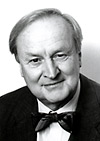 The
MedCoast Symposium is arranged on Friday 4 November
as part of
The
MedCoast Symposium is arranged on Friday 4 November
as part of 